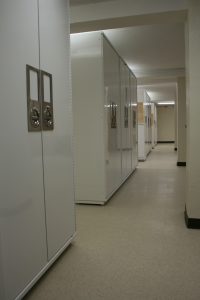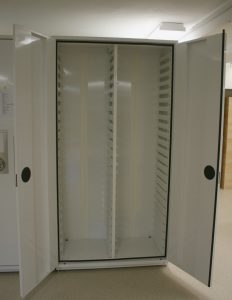By Theresa Dellinger
Our new insect cabinets are here! We now have museum-quality, archival cabinets specially engineered for the protective storage of our pinned specimens. The double-door cabinets are over 7’ tall and hold 48 Cornell drawers. They are made from heavy gauge steel and weigh almost 450 lbs. each. (I was relieved when we decided to hire a moving company to bring the cabinets into the collection room rather than attempt the job ourselves.)
The cabinets, along with the new archival Cornell insect drawers and unit trays, were purchased with funding from our grant from the National Science Foundation. Our Collections in Support of Biological Research (CSBR) grant (DBI# 1458045) has allowed us to upgrade the storage infrastructure of our pinned insect collection and secure it for the future.
Many of the old cabinets used in the collection were manufactured to order by inmates in the Virginia Department of Corrections in the 1960s. These older cabinets rarely matched in height, the doors tended to warp and jam, and they were painted a military olive green. Why do I mention the color of these old cabinets? Well, dark interiors make it difficult to visually check the bottom of the cabinets for signs of insect infestation. It’s very hard to see a small dead insect, insect exuvia, or any frass on a dark surface. Our new cabinets have a glossy white finish inside and out, which will make it much easier to inspect the cabinets for things that should not be there.
Our old cabinets were by no means tightly constructed to exclude pests that could damage the collection, but that was acceptable at the time. Fumigants such as naphthalene, paradichlorobenzene (both used in mothballs), and dichlorvos-impregnated strips (often called “pest strips”) were the primary means of protecting insect specimens from attack by dermestid beetles or other stored product pests. A certain measure of air flow into and within the cabinet was beneficial as it allowed the volatile insecticides to drift among the insect drawers. Mothballs were excellent repellents but didn’t always kill established pest populations; pest strips were very effective at eliminating pests. Collections often had these compounds inside each drawer as well as inside the cabinets for maximum protection. [See Collateral Damage: Unintended consequences of vapor-phase organic pesticides, with emphasis on p-dichlorobenzene and naphthalene, a paper by Kathryn A. Makos and Catharine A. Hawks (both of the National Museum of Natural History, Smithsonian Institution) for more discussion on the use of fumigants in natural history collections. )
So why don’t we still use these materials in insect collections? Most fumigants have been largely phased out of modern insect curation due to safety concerns about carcinogenic and other toxic effects on mammals (such as entomologists). In addition, naphthalene and paradichlorobenzene, when used simultaneously in the same cabinet, combine together to produce a liquid that can damage specimens. Naphthalene and paradichlorobenzene vapors can also recrystallize on specimens, which is also very undesirable.
Nowadays we primarily use exclusion techniques to prevent unwanted insects in the collection. Our new cabinets are tightly constructed with gaskets to be nearly air-tight. The Cornell drawers also very close fitting (to the extent that they can be hard to open, but we’re not going to complain about that).
We can use a sticky card at the bottom of each cabinet to trap any mobile insect inside the cabinet. However, this technique doesn’t monitor insect activity that might be limited inside a particular drawer. Also, many insects tend to move up when trying to escape and may fall on the lid of the top drawer when dead, rather than all the way to the bottom of the cabinet where the sticky card is placed. Frequent visual inspection of both the inside of the cabinet and in each drawer is a more effective method of detecting storage problems in a collection, as long as it is done on a regular schedule by someone who knows what signs to look for. Should we detect any sign of insect infestation in a cabinet, we can freeze insect drawers at -20º C for 3 days to kill immature and adult insects. Each drawer in the suspect cabinet should be frozen and the entire cabinet wiped down and vacuumed thoroughly.
Mold may become a greater problem than dermestid beetles now that insect collections can be stored in air-tight units. Ironically, naphthalene flakes and balls somewhat helped protect insect collections against the growth of mold by absorbing moisture from the air. Mold spores are ubiquitous and freezing will not kill them. To avoid problems with mold in a collection, all specimens must be thoroughly dried before adding them to an insect drawer.
We have a dehumidifier in the collection room that’s typically set for 35% moisture to help limit mold growth. We are also exploring the potential use of portable dehumidifiers that passively absorb moisture from the air. Portable dehumidifiers are often used in gun safes, closets, boat cabins, and other small areas where moisture gets trapped. These dehumidifiers contain beads that passively absorb moisture from the air. When saturated, as indicated by a color change to the beads, the units can be plugged into an outlet and “recharged” by drying out the beads for a number of hours. These would be ideal to place in each insect cabinet for extra protection against humidity and mold growth.
However, the low-tech solution against humidity in the cabinets would be to use humidity indicator cards. These flat cards can be hung on the cabinet door and visually checked each time the cabinet is opened. Increasing humidity levels in a cabinet are indicated by a color change on the card. If humidity is detected, then all the drawers in that cabinet should be visually inspected immediately for mold growth. One of the portable dehumidifiers could then be placed in the cabinet to remove the unwanted moisture, but if it’s humid enough to need a dehumidifier in the cabinet, then clearly all the drawers should be removed from the cabinet until the humidity has been corrected.
Hopefully the precautions we’re taking with tight seals and dehumidifiers will help avoid dermestid beetles and fluctuating humidity levels in our collection. However, these are common curation issues in natural history collections and they do occur from time to time. The real key to keeping a collection safe is vigilant monitoring on a regular basis. Administrators might find the idea of relying on a high-tech device to detect problems appealing, but in reality, several well-trained curators can monitor a collection much more effectively. Plus, we also identify specimens, lead tours, make labels, pin raw material, and remediate any problems once we’ve detected them!



